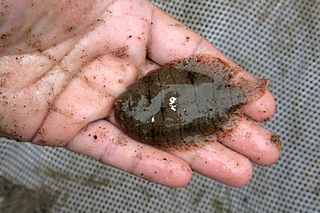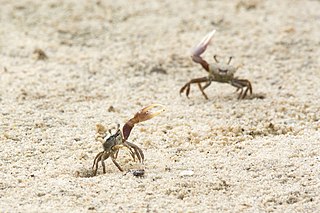
A fiddler crab, sometimes known as a calling crab, may be any of more than one hundred species of semiterrestrial marine crabs in the family Ocypodidae. A smaller number of ghost crab and mangrove crab species are also found in the family Ocypodidae. This entire group is composed of small crabs, the largest being slightly over two inches (5 cm) across. Fiddler crabs are found along sea beaches and brackish intertidal mud flats, lagoons and swamps. Fiddler crabs are most well known for their sexually dimorphic claws; the males' major claw is much larger than the minor claw, while the females' claws are both the same size.

Loliginidae, commonly known as pencil squids, is an aquatic family of squid classified in the order Myopsida.

The hogchoker is a small flatfish found along the Atlantic coast of North America, ranging from Massachusetts and Florida to Panama. They prefer brackish water, and are abundant in many bays and estuaries north of the Carolinas. It is a member of the American sole family Achiridae. They are usually brown to dark brown in color, and lighter on their "blind side". The overall body color is often broken by a series of spots and thin stripes, which can be lighter or darker than the main body color. The fins and tail have fringed edges helping hide the fish from its prey. They mainly feed on small aquatic insects and invertebrates. They are regarded as "trash fish" by recreational fishermen and were fed to pigs but they have rather bony bodies which were sometimes difficult for the pigs to swallow, hence the vernacular name.

Leptuca pugilator, the sand fiddler crab, Atlantic sand fiddler crab, or Calico fiddler, is a species of fiddler crab that is found from Massachusetts to the Gulf of Mexico. It lives in burrows in coastal and estuarine mud-flats, and can be extremely abundant. It can be differentiated from the morphologically similar Minuca pugnax and Minuca minax by the smoothness of the inside of its claws. One claw is larger than the other, and can be much larger than the crab's body, at up to 41 mm (1.6 in) long.

Vittina natalensis, common name spotted nerite, is a species of small freshwater snail with an operculum, an aquatic gastropod mollusk in the family Neritidae, the nerites.

Minuca pugnax, commonly known as the Atlantic marsh fiddler crab, is a species of fiddler crab that lives on north-western shores of the Atlantic Ocean.
Lolliguncula brevis, or the Atlantic brief squid, is a small species of squid in the Loliginidae family. It is found in shallow parts of the western Atlantic Ocean.

Minuca minax, commonly known as the red‐jointed fiddler crab or brackish-water fiddler crab, is a species of fiddler crab that is found in the United States from Massachusetts to the Gulf of Mexico. It is one of the most common macroinvertebrates in salt marshes in these states. It prefers areas of lower salinity than other fiddler crabs, and can be found in great numbers along the banks of tidal streams, even at distances greater than 50 km (31 mi) from the sea.

Vittina turrita is a species of aquatic snail, a gastropod mollusk in the family Neritidae.
Lolliguncula is a genus of squid from the family Loliginidae from the eastern Pacific and western Atlantic, known as brief squid. The genus is divided into two subgenera Lolliguncula and Loliolopsis. They are rather small squids with a maximum mantle length of 120mm, that inhabit shallow warm seas, although some species have been recorded in areas of low salinity. They are typified by having a short mantle, which is round at the posterior; and fins that are broader than long, but which have no posterior lobes. The males produce spermatophores with a long cement body and they lack a ventral crest on their hectocotylus. Their suckers have square teeth which ring the entire margin or are placed distally. The males do not have enlarged suckers on the left ventral arm. The tentacular club is expanded and contains suckers in four series. The two subgenera differ in the morphology of the hectocotylus.
Leptuca spinicarpa, commonly known as the spiny-wristed fiddler crab or the spined fiddler crab, is a species of fiddler crab native to coastal habitats along the Gulf of Mexico from northwestern Florida to Mexico.

Leptuca panacea, commonly known as the Gulf sand fiddler crab or the Panacea sand fiddler, is a species of fiddler crab native to coastal habitats along the Gulf of Mexico from northwestern Florida to Mexico.
Leptuca speciosa, commonly known as the brilliant fiddler crab or the longfinger fiddler crab, is a species of fiddler crab native to the southern United States, Mexico, and the Caribbean.
Leptuca leptodactyla, commonly known as the thin-fingered fiddler crab or the western Atlantic fiddler crab, is a species of fiddler crab native to the western Atlantic coast of the Americas.
Leptuca cumulanta, commonly known as the heaping fiddler crab or the mangrove fiddler crab, is a species of fiddler crab native to tropical and subtropical areas of the western Atlantic.
Leptuca uruguayensis, commonly known as the Uruguayan fiddler crab or the southwestern Atlantic fiddler crab, is a species of fiddler crab native to temperate and subtropical areas of the southeastern coast of South America.







